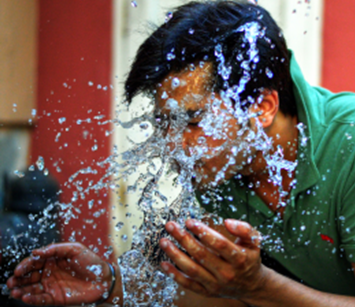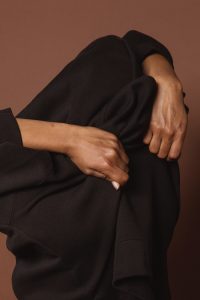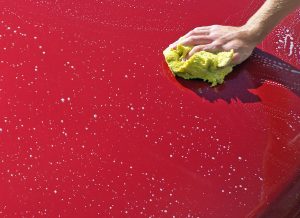61 Capítulo 6: Sección 2: Los verbos reflexivos
Section Goal
In this section, students will learn to narrate what they do to get ready in the morning.
Vocabulario
Los verbos reflexivos
- Afeitarse
- Lavarse
- Llamarse (to call oneself, your name)
- Acostarse (o:ue)
- Levantarse
- Cepillarse
- Ducharse
- Bañarse
- Divertirse (e:ie)
- Dormirse (o:ue)
- Irse
- Maquillarse
- Vestirse (e:i)
- Ponerse
- Despertarse (e:ie)
- Relajarse
- Quitarse
- Quedarse
- Sentirse (e:ie) + adjetivo
- Frustrarse
- Enojarse
- Alegrarse
- Enamorarse (de)
Gramática: Reflexive Verbs



How reflexive verbs work
To conjugate reflexive verbs, first change the “se” you see at the end of the infinitive based on the doer of the action (this is called the reflexive pronoun).
Step one: Change the “se”
| (Yo) Me | (Nosotr@s) Nos |
| (Tú) Te | (Vosotr@s) Os |
| (Usted, él / ella, 1 cosa) Se | (Usted, ell@s, 2+ cosas) Se |
Step two: Decide where the reflexive pronoun will go
If you have a one-verb phrase, the pronoun must go in front of the conjugated verb.
- Me lavo las manos con frecuencia.
If you have a two-verb phrase (the second verb will be an infinitive or a gerund), you can either put it in front of the conjugated verb or attach it to the end of the infinitive or gerund. It doesn’t matter which you choose, as the meaning stays the same, and one style is not better than the other. If you attach a pronoun to a gerund, put an accent where the stress would fall if the pronoun weren’t there.
- Me tengo que lavar las manos con frecuencia.
- Tengo que lavarme las manos con frecuencia.
- Me estoy lavando las manos.
- Estoy lavándome las manos.
Remember this: Un verbo = una opción. Dos verbos = dos opciones.
Note: When using reflexive verbs with parts of the body, use el/la/los/las instead of possessive adjectives. Because of the reflexive verb, we already know the body part belongs to that person.
Lavarse
- Me lavo mis manos. (Incorrect)
- Me lavo las manos. (Correct)

There are also a lot of reflexive verbs that demonstrate a change in emotion (“to get”), such as:
- Frustarse
- Animarse
- Alegrarse — “Me alegro”
- Enamorarse
Step three: Conjugate!
Change the ending of the verb based on the subject as you normally do.
Note: We have not seen commands yet, but when we do, we will see that if you have an affirmative command that requires a reflexive pronoun, you must attach the pronoun to the end of the command.
- Mijo, ¡Lávate las manos!
Also, if you use gustar, attach the reflexive pronoun to the end of the infinitive.
- No me gusta lavarme la cabeza por la noche.
| Llamarse: to call oneself | |
| (Yo) Me | (Nosotr@s) Nos |
| (Tú) Te | (Vosotr@s) Os |
| (Usted, él / ella, 1 cosa) Se | (Usted, ell@s, 2+ cosas) Se |

| Lavarse: to wash oneself | |
| (Yo) Me | (Nosotr@s) Nos |
| (Tú) Te | (Vosotr@s) Os |
| (Usted, él / ella, 1 cosa) Se | (Usted, ell@s, 2+ cosas) Se |
| Divertirse: to have fun (e:ie) | |
| (Yo) Me | (Nosotr@s) Nos |
| (Tú) Te | (Vosotr@s) Os |
| (Usted, él / ella, 1 cosa) Se | (Usted, ell@s, 2+ cosas) Se |
| Cepillarse: to brush oneself | |
| (Yo) Me | (Nosotr@s) Nos |
| (Tú) Te | (Vosotr@s) Os |
| (Usted, él / ella, 1 cosa) Se | (Usted, ell@s, 2+ cosas) Se |
| Ponerse: to put on oneself / to get ____ | |
| (Yo) Me | (Nosotr@s) Nos |
| (Tú) Te | (Vosotr@s) Os |
| (Usted, él / ella, 1 cosa) Se | (Usted, ell@s, 2+ cosas) Se |
| Irse: to leave | |
| (Yo) Me | (Nosotr@s) Nos |
| (Tú) Te | (Vosotr@s) Os |
| (Usted, él / ella, 1 cosa) Se | (Usted, ell@s, 2+ cosas) Se |

| Maquillarse: to put makeup on oneself | |
| (Yo) Me | (Nosotr@s) Nos |
| (Tú) Te | (Vosotr@s) Os |
| (Usted, él / ella, 1 cosa) Se | (Usted, ell@s, 2+ cosas) Se |
| Relajarse: to relax | |
| (Yo) Me | (Nosotr@s) Nos |
| (Tú) Te | (Vosotr@s) Os |
| (Usted, él / ella, 1 cosa) Se | (Usted, ell@s, 2+ cosas) Se |
Actividad 8. ¡A conjugar!
Actividad 9. ¿Reflexivo o no?
Instrucciones: Pon una marca al lado de la foto que muestra una acción reflexiva del verbo reflexivo. Después escribe el infinitivo de cada uno de los verbos.
1.

2.

3.

4.

5.

Actividad 10. Tu rutina de la mañana
Instrucciones: Ordena estas actividades en orden cronológico de 1 a 11 de acuerdo a tu rutina. Pon una X en las actividades que no corresponden a tu rutina.
- Me lavo la cara
- Me afeito la cara
- Me despierto
- Me cepillo los dientes (por la mañana)
- Me afeito las piernas
- Me cepillo los dientes (por la noche)
- Me cepillo el cabello
- Me levanto
- Me ducho
- Me maquillo
- Me visto
Actividad 11. Los productos personales
Instrucciones: Usa las siguientes palabras del banco de palabras (word bank) para completar cada oración.
- Colgate
- gel de ducha
- champú
- jabón
- Maybelline
- Me lavo la cabeza con
- Me cepillo los dientes con
- Me maquillo con
- Me ducho con
- Me lavo las manos con
Actividad 12. Preguntas personales
Instrucciones: Preguntas personales. Contesta las siguientes preguntas usando verbos reflexivos en tus respuestas. Después entrevista a un compañero en español. Usa este video como ejemplo de respuestas. Si quieres escuchar las preguntas, puedes usar este audio.
Modelo: ¿A que hora te duermes? Me duermo a las 11 de la noche.
- ¿A qué hora te despiertas?
- ¿A qué hora te levantas?
- ¿A qué hora te acuestas?
- ¿Te quitas los zapatos cuando llegas a casa?
- ¿Con qué frecuencia te vistes profesionalmente?
- ¿Con qué frecuencia te vistes elegante?
- ¿Con qué frecuencia te vistes casualmente?
- ¿Te diviertes en las clases?
- ¿Tienes que ponerte un uniforme para el trabajo?
Actividad 13. ¿Qué hacen ellos?

Instrucciones: Completa la oración conjugando los siguientes verbos reflexivos. El primer blanco es para el pronombre y el segundo es para el verbo.
Modelo: Esteban se levanta muy temprano. (levantarse)
- María José (ducharse) antes del trabajo.
- Samuelito (acostarse) las ocho de la noche.
- La banda de Ester (llamarse) Las Reinas del Rock.
- Tú vas a (vestirse) de negro para el funeral, ¿verdad?
- Mis papás (levantarse) muy temprano.
- Miguel Ángel (vestirse) profesionalmente todos los días porque es un banquero.
- Usted (llamarse) Jorge Rivera, ¿no?
- ¿Ustedes (cepillarse) los dientes con Crest, Colgate u otra marca de pasta dental?
- Yo (levantarse) a las siete de la mañana.
- Nosotros (ponerse) frustrados cuando hay un embotellamiento (traffic jam) en la carretera (highway).
Actividad 14. ¿Cómo te pones?
Instrucciones: ¿Cómo te pones? Usa los siguientes verbos reflexivos para mostrar cambios en emociones y contestar las siguientes preguntas acerca de cómo te sientes en diferentes situaciones. Puedes usar los verbos más de una vez.
Modelo: ¿Cómo te pones cuando tienes un examen? Me pongo enojado.
- ponerse + adjetivo
- frustrarse
- enojarse
- alegrarse
- enamorarse
- ¿Cómo te pones cuando no entiendes la lección de español?
- ¿Cómo te pones cuando recibes una nota buena en un examen difícil?
- ¿Cómo te pones cuando tienes una entrevista de trabajo?
- ¿Cómo te pones cuando un amigo te miente (lies to you)?
- ¿Cómo te pones cuando conoces a tu media naranja (soulmate)?
- ¿Cómo te pones cuando no duermes bien?
- ¿Cómo te pones cuando pasas tiempo con amigos?
- ¿Cómo te pones cuando encuentras veinte dólares en tu bolsillo (pocket)?
- ¿Cómo te pones cuando tienes que estudiar para un examen?
Media Attributions
- l

